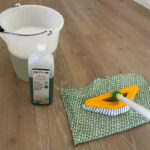
Laying and useful suggestions
WOOD AND WOOD FLOORING
Thanks to its excellent strength and resistance, wood has been the most widely used building material for centuries.
A natural material, it has a fibrous structure, where the fibres mostly run in a single direction, parallel to the growth of the tree. Its physical and mechanical properties, as a result, vary depending on the way the grain runs.
The natural colour of the wood depends on the colour of the cell walls and the colour of the substances inside these cells. The colour of the wood changes with the years: exposure to air and light involves changes (sometimes quite marked) in the colour of the cell walls (oxidation).
The special features of wood floors include good thermal insulation, sound insulation, wear resistance, hardness and spring.
In addition to creating a warm, elegant and welcoming atmosphere for any room, a wood floor lasts a lifetime: all you need do is gently sand it down to restore its original beauty.
THE SCREED
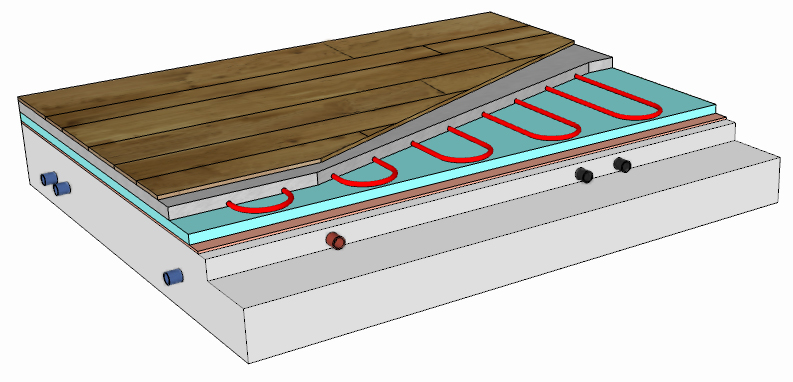
The screed can be formed using various materials (the most common is cement-based, though other materials used are wooden panels, sand, pre-existing flooring etc.).
The cement screed must be at least 5 cm thick and should be left to dry and harden for a suitable time, which can vary (from 15 to 90 days or more) according to the type of cement (chemical quick-setting or traditional), its thickness and site conditions. A ringing sound must be heard when tapped with a hammer; the surface must be perfectly even and homogeneous, must not create dust or crumble and under no circumstances must there be any damp spots or marks. It must be deep enough to ensure rigidity and strength and to withstand the expected static and dynamic loads on the floor without deformation.
It should not have pipes running through it (these are best laid in the lower layer) and a vapour barrier should be placed between the last layers (a sheet of polyethylene 0.5 mm thick to prevent rising damp).
Residual humidity in the screed must not exceed 1.7 – 2%. During the design stage, it is a good idea to distance the screed from the walls using appropriate construction joints, as well as providing appropriate contraction joints at the thresholds.
PROPER ENVIRONMENTAL CONDITIONS AND UNDERFLOOR HEATING
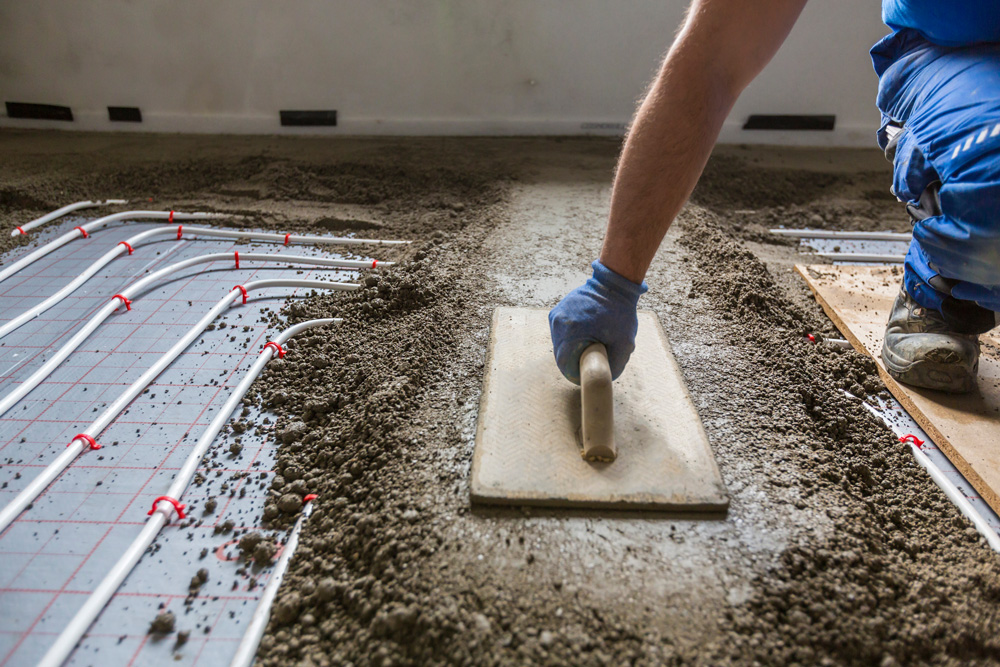
Wood is a healthy solution for heated flooring. Naturally insulating, this material prevents direct contact with the heat emitted by the heat radiating panels, thus greatly improving home comfort (the heat is constantly and “gently” distributed) and ensuring a relatively more suitable level of atmospheric heat.
Certain measures are, however, essential at the design stage.
Provided that the heating system has been installed in a workmanlike manner and that the heating pipes in the floor are covered by 3 cm cement screed, before laying the wood floor it is essential to run the heating system, gradually increasing the water temperature until the ambient temperature reaches approx. 20-25° and maintaining it for about 15 consecutive days. After this gradually reduce the temperature over the next 7 days and then switch off.
With a screed more than 5 cm deep, it is advisable to repeat the above procedure a second time.
The floor should be laid with a bonding system using adhesive, avoiding any air pockets between the screed and the floor boards, since they reduce the efficiency of heat transfer. The wood elements must be fully bonded to the substrate.
A floating floor should be laid over a suitable mat/membrane that transmits heat.
Generally speaking, we recommend laying a well-structured wood floor that can guarantee in the future flexibility due to the natural movements of the wood on the heated flooring. Remember that wood, despite being a natural insulating material, transmits heat evenly, avoiding a direct transmission, which can be uncomfortable for the human body, especially in long stay locations. Furthermore, wood in spring and fall, when the underfloor heating is switched off, can give you warmth and comfort, contrary to the ceramic, marble, cotto tile or tile, which stays cold!!
Ever more frequently, wood floor is being used for underfloor heating, because it reduces the direct warmth from the heat radiating panels and distributes it for the comfort of those who live there. Not all types of wood can be laid over underfloor heating systems: it is not recommended to use particularly hygroscopic wood species, such as Beech, Wenge, Afromosia, Maple, Larch and Fir. The relevant information on each wood is given in the documents provided to our dealers.
A good stability of the planks, the wood and the finishing, can be maintained with a controlled ambient relative humidity (A.R.H.) at 45% – 65% and with a room temperature of between 16° C and 22° C.
All houses built today are extremely well insulated; while in the past there were problems of moisture infiltrations, now it is quite the opposite. But be careful, because too much insulation, together with steady temperatures of over 20° C, during the drier winter months (November-March), can remove the moisture from the air in the home, to the point where it drops below the basic minimum values for a good ambient balance (45% A.R.H.); with the result that everything in the house becomes dry, dehydrated and starts to suffer, mainly the natural components such as greenery or wood, and consequently furniture, decor accessories, floorings, coverings and, not least, the health of the people who live there, increasing dust transmission, dryness of nasal mucous and the airways, as well as the electrostatic field and thereby general wellbeing.
Also apartment blocks with central heating (not underfloor heating), or homes in which it is difficult to control the heating temperature, during the winter months can encounter these kind of problems. That is why it is good, in the winter months, to use humidifiers with a hygrometer, to control the ambient humidity, which should be between 45% and 65%.
Please note that excessive dehydration of the wood (due to heat transfer or high temperature heating) can cause cracks on the surface of the wooden planks (of any wood species). To avoid this excessive wood dehydration, you simply need to balance the environment with air humidity. The good norm is considered to be an ambient humidity between 45% and 65%, and these values can be maintained by humidifiers or humidity regulators.
WHEN TO INSTALL PARQUET FLOORING TO ENSURE AUTHENTICITY AND WARRANTY
To preserve the longevity and integrity of your parquet flooring, it is crucial to conduct the installation after the completion of all internal construction works. This should take place in an enclosed and climate-controlled environment, with controlled ambient conditions, as already outlined on this page.
“Internal construction works” encompass all building activities, including masonry, the application of drywall, painting, installation of marble, tiles, and sanitary fixtures, etc.
In practice, parquet flooring should only be laid in fully completed premises, followed by the installation of internal doors and furnishings. These recommendations are essential to prevent significant damage to the wood’s surface and finish.
From our experience, dust from plaster, cement, paint, adhesives, and glues used in construction can cause irremovable or hard-to-remove dirt that alters the aesthetic originality surface. Moreover, the wood can get scratched and damaged from scuffs and impacts that commonly occur during mechanical movements on-site.
Being covered does not guarantee that these incidents will not happen. Therefore, ensuring that these guidelines are followed will help guarantee the validity of the parquet’s warranty and preserve its beauty over time.
Each parquet supply comes with a product identification sheet, and further information or advice on laying and maintaining your parquet flooring is available.
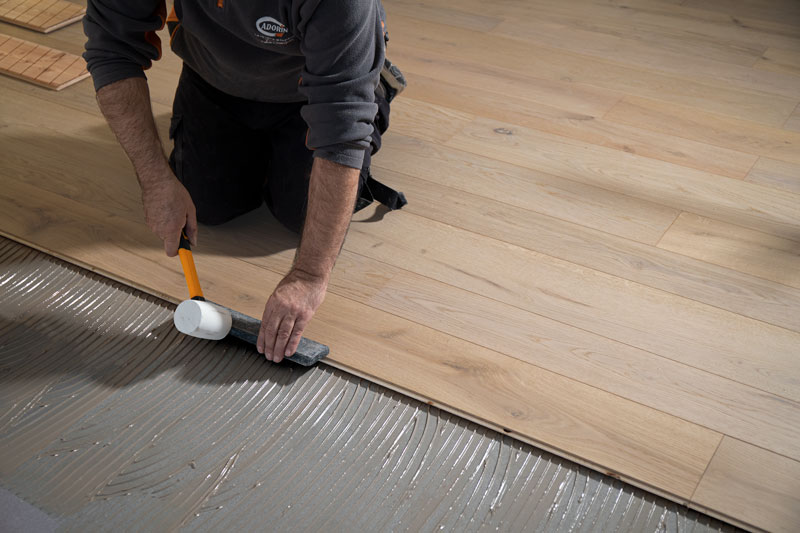
LAYING WITH ADHESIVES
This technique involves laying the wood planks by gluing them to the substrate. After choosing the side of the room you want to begin from (taking into account aesthetic effects), lay the first plank with the groove (female joint) facing the wall. Use special wedges to distance the wood floor from the wall by approx. 8/11 mm around the perimeter.
We advise laying a few rows of planks without adhesive initially to decide on the layout (open several packs to choose the best planks) and pattern (width and length) and any cutting that may be necessary at the ends.
Now remove and stack the planks in the same order just outside the area to be laid and evenly apply the suitable adhesive over the substrate using a spreader. Then lay the wood elements as decided previously, taking care not to get adhesive on the exposed surface, to use specialized soft tools and professional bumpers specifically designed to prevent damage to the edges of the planks during installation.
LAYING FLOATING FLOORS
The floating system consists of laying the wooden planks on a mat or membrane and just gluing the joints together. This system allows the entire floor to “float” as the wood naturally settles.
First you need to lay a foam or felt mat (about 2 mm thick) in order to ensure even contact between the floating wood floor and the floor on to which it is laid, and to prevent the creation of areas with different sounds. The mat should extend up the wall, behind the skirting boards.
The density of the mat must be sufficient to withstand the static or dynamic loads expected for the intended use of the floor.
After choosing the side of the room you want to begin from, lay the first plank with the groove (female joint) facing the wall. Use special wedges to distance the floor from the wall by approx. 10 mm.
In the case of rooms measuring more than 4×4 metres, we recommend interrupting the laying of the planks and inserting expansion joints. This is also recommended at points where the wood floor meets other floors or thresholds, using profiles or joint covers.
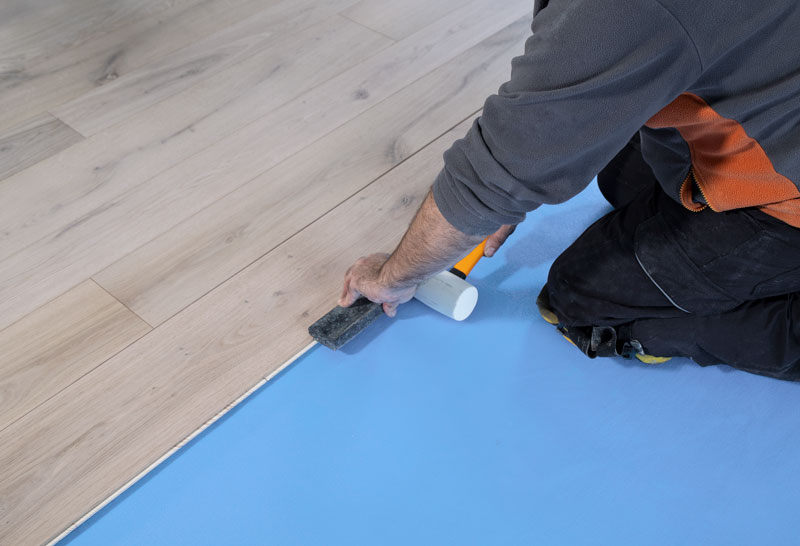
CHECKS PRIOR TO LAYING
The wood floor must be stored in a dry place, in a horizontal position and without removing the packaging. Do not store on sites where underfloor heating is switched on.
Prior to laying the wood floor, use a hygrometric instrument to measure the moisture content of the substrate and the abutting walls in the various areas where the wood floor is to be laid.
Make sure that the walls, plaster and fittings are all perfectly dry before laying the wood floor: residual humidity must not be more than 2%. The ambient relative humidity must be between 45% and 60%. The room temperature must not be less than 14° C. Windows, shutters and external doors should be fitted and working properly. The room where the parquet flooring is to be laid must be well aired and protected against the weather or sudden changes in temperature.
To guarantee top results, we strongly recommend that the wood floor is only laid once all building work has been completed (apart from hanging internal doors and fitting the skirting boards).
It is always advisable to apply a suitable vapour barrier to further protect the wood against moisture in the substrate and perimeter walls.
See the product identification sheet enclosed with the shipping documents to see whether the laying system you intend to use (gluing to screed, floating on a mat or nailed into position) actually suits the type of wood floor purchased.
FINISHING AFTER LAYING
If the wood floor is supplied unfinished, the fitter must arrange for the subsequent professional finish.
In the case of supplies of pre-finished parquet flooring, finish as indicated in the instructions provided inside the packaging.
PREFINISHED (OIL, WAX AND VARNISH)
In the case of a parquet pre-finished with oil/wax/varnish, optimum protection is achieved approximately 20-30 days after laying with exposure to light and air in an environment with constant humidity (45-65%) and room temperature (16-22°). It is advisable to take great care during this period and wear soft footwear.
If further building work is required, you must protect the wood floor by covering it with a thick, soft and non-sticky breathable material to ensure that the pre-finished parquet flooring does not become scratched, damaged or dirty.
In the case of pre-finished parquet flooring using natural oil or wax, let it settle for 8-10 days and then apply a coat of undiluted protective liquid emulsion, following the manufacturer’s instructions. This will ensure that the wood is properly fed and extends the time before it needs renewing.
SOME PRATICAL TIPS
– Always make sure rooms with parquet flooring are well aired
– Keep the room temperature between 15 and 22° C
– Keep the ambient relative humidity between 45% and 65%
– Avoid covering the wood floor for a long periods with carpets and avoid using non colour-fast rugs
– When washing the wood floor, do not pour water directly onto the floor, but always use a damp cloth
– Protect the wood floor during building work and repairs
– Always use the cleaning and maintenance products recommended by the suppliers
As indicated in the Italian Consumer Code, the consumer must be handed the product identification sheet issued by the manufacturer (Italian Law No. 126 of 10 April 1991 “Standards for consumer information” and Italian Decree Law No. 101 of 8 February 1997 “Regulations for implementation”). This sheet accompanies the goods on delivery, being attached to the shipping document provided in the packs together with the information sheet.
